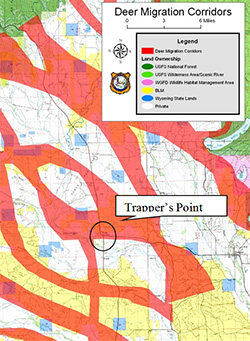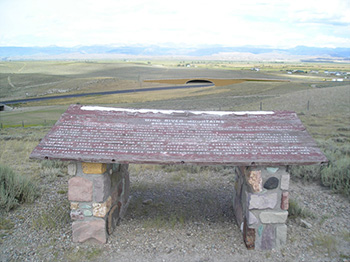Awards
Exemplary Ecosystem Initiatives — 2011
Wyoming: Wyoming's Collaborative Effort to Preserve the Trappers Point Wildlife Corridor through Highway Safety

Figure 1. Trapper's Point falls within major deer migration corridors (in red).
Source: WYDOT
Wyoming's Collaborative Effort to Preserve the Trappers Point Wildlife Corridor through Highway Safety is a large-scale wildlife connectivity effort aimed at protecting Wyoming's big game species, including pronghorn antelope, mule deer, and moose, which frequently travel along the Upper Green River Valley Corridor from Jackson Hole to the southwestern part of the State. With support from multiple Federal and State agencies and non-profit organizations, Wyoming Department of Transportation (WYDOT) intends to complete construction on two 150-foot-wide overpasses and six underpasses as part of this project by 2012.

Figure 2. Map illustrating pronghorn migration patterns using GPS location data
Source: Wildlife Conservation Society
US 191, a major highway, runs directly through the Upper Green River Valley Corridor at Trapper's Point, a location named for its natural terrain that clusters migrating herds. Many animal herds migrate along the corridor, contributing to a high rate of animal-vehicle collisions (AVCs). From 2000 to 2009, AVCs resulted in 538 wildlife deaths. WYDOT's initiative works to reduce the dangers brought by the intersection of the highway and the wildlife migration corridor. The initiative aims to implement over- and underpasses in heavily-traveled wildlife avenues on a nine-mile segment of US 191 west of Pinedale, Wyoming.
In order to develop the most effective wildlife crossing structures, WYDOT partnered with Federal and State agencies, including the Federal Highway Administration, U.S. Forest Service, U.S. Fish and Wildlife Service, Bureau of Land Management, and Wyoming Game and Fish Department, as well as non-profit organizations like the National Fish and Wildlife Foundation, Biodiversity Conservation Alliance, Greater Yellowstone Coalition, Wyoming Outdoor Council, Rocky Mountain Elk Foundation, and National Geographic. These partnerships performed extensive research to prepare crossing strategies and identify appropriate locations for structures. National Geographic also developed a video documenting the research process.
The partnership's research identifies wildlife migratory routes, which are limited by the region's natural terrain, and further confirms that US 191 intersects with many of these paths. Using these findings, the partnership evaluated over- and underpasses as options for crossing structures. Previous research found that underpasses support mule deer crossings, but pronghorn antelope are wary of these structures. Pronghorn antelope typically live in open areas, and traveling through underpasses goes against their instinctive behaviors. When faced with underpasses, pronghorn antelope will often bypass the structures and find alternative ways to cross roadways.
WYDOT and its partners agreed to build two 150-foot wide overpasses and six underpasses on US 191 to support all types of big game movement. The construction of the over- and underpasses will provide easier passage across US 191 for large animal species, reduce AVCs, and promote better wildlife connectivity along the Upper Green River Valley Corridor.
For more information, contact Timothy Stark, P.E., Wyoming Department of Transportation, at timothy.stark@dot.state.wy.us.

Figure 3: Trapper's Point historic marker and location in Pinedale, Wyoming
Source: WYDOT

Figure 4: Wildlife crossing construction underway at Trapper's Point
Source: WYDOT

